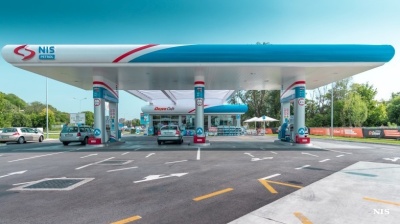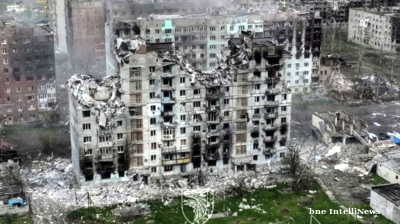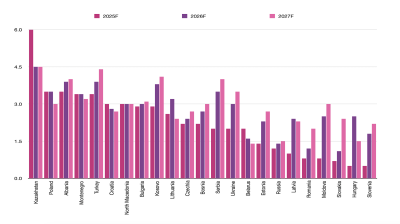The joint Russia and Belarus military exercises get underway on September 12 that will be closely watched by Nato analysts to gauge how strong Russia’s military has become after more than three years of war.
This is the first time the annual exercises have been held since the war in Ukraine started in 2022 where usually the combined Russian and Belarusian military field over 100,000 men to enact the start of hostilities with Europe.
Likewise, some analysts speculate that the Polish drone incursion on September 10 was a test of Nato air defence capacities by the Kremlin ahead of the exercises to see how ready Nato is to repel a Russian attack.
The Zapad exercises come on top of an already jumpy Europe. The dozen drones unsettled the EU allies and provoked the first active military response by a Nato member to Russian armament over its own territory since the war in Ukraine began. Polish Prime Minister Donald Tusk triggered Nato’s Article 4 the same day, which calls for consultations with allies if a country’s security is threatened. Poland has since imposed a no-fly zone and closed its eastern borders with Belarus.
If that was the case then Nato failed the test, say some. Some of the Russian reconnaissance drones (they were not carrying explosives) travelled deep inside Polish territory avoiding Polish jet fighters. Eventually, several F-34s from Holland had to be scrambled to join the defence and bring the last of the dozen drones down.
Tusk called Zapad-2025 “very aggressive” and said the exercises would take place “very close” to the Polish border. Senior Ukrainian officials have also warned that Russia could use the exercises as cover to prepare another attack from Belarus.
Belarusian officials said the drills will be smaller than usual and held deeper inside Belarusian territory as a gesture of de-escalation. Belarus President Alexander Lukashenko has been negotiating with the White House in an effort to repair some of the poor relations. The Belarusian strongman released another 52 political prisoners on September 11 and the US lifted sanctions on the national airline Belavia in response. Lukashenko has been enjoying increasingly warm relations with the Trump administration which he is hoping to use to gain some sanctions relief and give himself some leverage in his relations with Putin. The prisoner relief this week follows on from the release of 16 prisoners in June, including Sergey Tikhanovsky (Siarhei Tsikhanouskiy), the husband of Belarusian opposition leader Svetlana Tikhanovskaya (Sviatlana Tsikhanouskaya) in a US-brokered pardon after envoy Keith Kellogg met with President Lukashenko in Minsk.
Minsk has invited foreign observers to Zapad-2025, including from nine NATO countries, to monitor the exercises for “openness and transparency.”
The Russian forces on display will be reduced from normal by the needs of the ongoing campaign in Donbas, but the Kremlin is expected to show off its hardware in a show of strength. The Kremlin has ramped up military production and is now producing more arms and ammo than it needs on the battlefield, according to military analysts, allowing it to start the process of restocking and rebuilding its military – a process that is expected to last a decade.
Russia’s drone production is already on a par with Ukraine’s or ahead after new factories were built deep in its hinterland, and the Kremlin plans to double missile production this year to 2,500 units per year. In 2024 alone, Russia produced and refurbished an estimated 1,550 tanks, 5,700 armoured vehicles and 450 artillery pieces of all types. It also deployed 1,800 long-range Lancet loitering munitions3. Compared to 2022, this represents a 220% increase in tank production, 150% in armoured vehicles and artillery, and 435% in long-range loitering munitions, according to a report by the Bruegel think tank.
“Most of this is modernised Soviet equipment, but Russian production will continue, albeit at a reduced tempo, once Soviet stockpiles are exhausted. This reduction will be felt less if it occurs after hostilities in Ukraine have ended,” Bruegel said in a report.
Ukraine has also been ramping up its defence production under the so-called Danish model and has increased its domestically produced military supplies to 60% of its needs, from 40% at the start of this year, Ukrainian President Volodymyr Zelenskiy said this month.
Europe, however, has been left trying to catch up. As bne IntelliNews reported, as Europe failed to sign defence sector procurement contracts since the start of the war, the European defence manufacturers were unable to make the investments to boost production to keep up with Russia. Belatedly, European Commission President Ursula von der Leyen announced the new €800bn ReArm programme on March 4 where she pointed out that Russia was already producing in three months what the combined Europe and Ukraine were producing in a year.
Defence spending this year has already soared to €170bn as the so-called Zeitenwende gets underway and the EU rolls out a €150bn SAFE (Security Action for Europe) defence loans that are now already fully disbursed. But as bne IntelliNews reported, there is a question mark over Europe’s ability to fund the rest of the €650bn of planned spending, as most EU countries are either in recession or approaching a crisis.
Russia's manufacturing prowess has been called into question and Western technology sanctions were imposed to cut the Kremlin off from essential technology needed to build its missiles and other weapons. However, those sanctions largely failed as Russia found workarounds and in the meantime Chinese technology has increasingly replaced western components.
Western intelligence agencies have been warning that Russia could be in apposition to attack Europe sometime in the next five years with a massive and well-armed force. The Russian presence in Ukraine at the end of 2024 stood at roughly 700,000 troops, and the Ministry of Defence has plans to double that force.
“A Russian attack on a European Union country is thus conceivable,” says Bruegel. “Assessments by Nato, Germany, Poland, Denmark and the Baltic states put Russia as ready to attack within three to ten years. It could be sooner, with the quadrennial Zapad military exercises taking place in Belarus in summer 2025. These will demonstrate Russia’s ability to manage military exercises at scale even during a war.”
In a prelude to the Zapad exercises, Belarus and Russia already held Collective Security Treaty Organisation (CSTO) military drills between August 31 and September 6 at Losvido and Lepelsky training ranges, both located in Belarus’s northeastern Vitsebsk region next to the border with Russia.
Those exercises in Belarus involve over 2,000 troops, as well as 450 units of equipment, nine aircraft and helicopters, and 70 UAVs, according to Major General Pavel Muraveiko, the chief of the Belarusian General Staff in manoeuvres are closely linked to the objectives of the Zapad-2025.
CSTO drills are held several times a year. Additional manoeuvres are planned in Kyrgyzstan and Tajikistan in October 2025. Formed in 2002 as Moscow’s answer to Nato, the CSTO is a union of six former Soviet states: Armenia, Belarus, Kazakhstan, Kyrgyzstan, Russia, and Tajikistan.
Ahead of the drills, EU member states bordering Belarus have launched their own military exercises — Iron Defender-25 with 30,000 troops in Poland, the Thunder Strike drills involving 17,000 troops in Lithuania, and Namejs 2025 in Latvia, with 12,000 personnel.
News

Serbia’s NIS posts 9-month net loss as US sanctions weigh on performance
NIS, majority-owned by Russia’s Gazprom Group, said it had operated in “extremely complex circumstances” after sanctions were announced by the US Treasury Department.

Nigeria's Heirs Energies' CFO on powering growth via sustainable, indigenous-led development
NewsBase speaks exclusively to Samuel O. Nwanze, Executive Director and Chief Financial Officer of Nigerian indigenous integrated oil and gas company Heirs Energies.

Brazil's Lula "horrified" as Rio police raid death toll reaches at least 130
Brazilian President Luiz Inácio Lula da Silva expressed shock at the fatalities from a massive police operation targeting Rio drug gangs that left scores dead, while residents and rights advocates accused authorities of summary executions.

Nigeria's NNPCL weighs technical equity partnerships to revive idle state-owned refineries
NNPCL is reviewing options to bring the Port Harcourt, Warri and Kaduna refineries back into meaningful operation, possibly by bringing in technical equity partners to upgrade or repurpose units.




